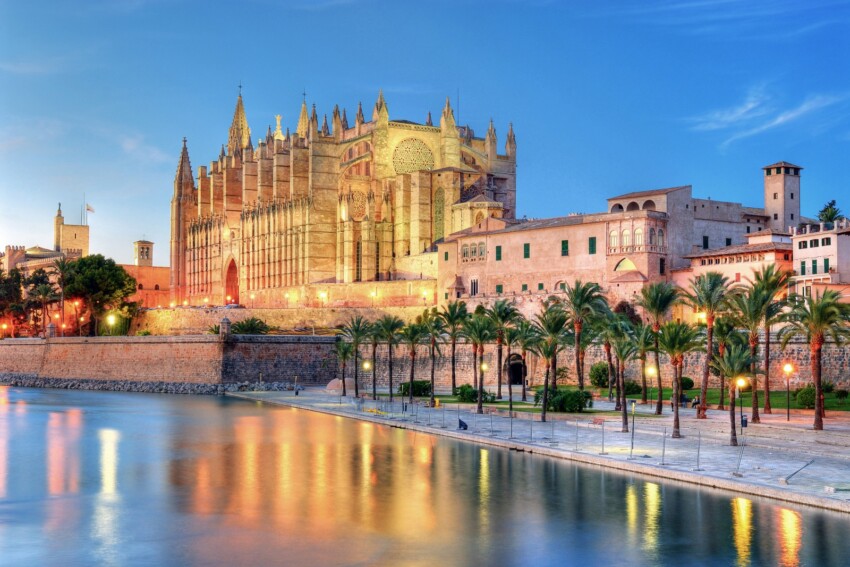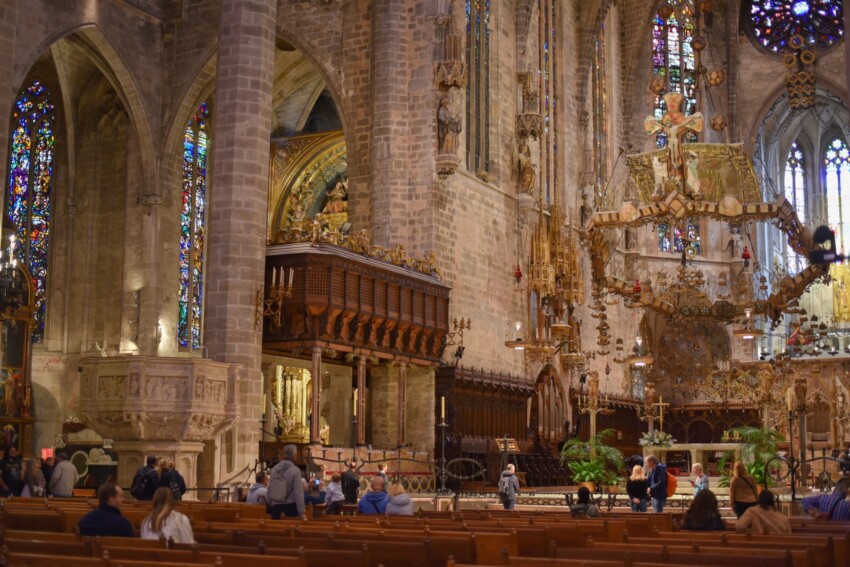
Palma de Mallorca Cathedral, also known as Santa Maria Cathedral or La Seu de Mallorca, is the main religious building not only of the city but also of the island. Located right in front of the sea near the Almudaina Royal Palace, the Cathedral was awarded the title of Basilica Minor in the early 20th century.
Its construction dates back to the 13th century when James I, King of Aragon and Count of Barcelona, having driven out the Arabs, decided to pull down the large mosque and build a cathedral dedicated to Saint Mary in its place. Construction began in 1329 and the church was consecrated in 1346 although it was not fully completed.
Now this splendid religious building is famous for its size, making it one of the largest cathedrals in Europe, but also because restoration work was carried out in the 20th century by the Catalan architect Antonio Gaudi.

Santa Maria Cathedral measures approximately 120 metres long, 70 metres wide and covers an area of 6,600 m². Built in Gothic style with sandstone blocks, the Cathedral has a three-nave floor plan with the main nave housing the Trinity Chapel where the tombs of King James II and King James III are located. In the area of the Royal Chapel, however, is the high altar with its canopy designed by architect Antonio Gaudi. Other interventions by Gaudi concerned the choir area, the bishop’s throne and the Chapel of the Holy Trinity.
The 61 stained glass windows in the aisles allow beams of light to enter at different times of day, creating extraordinary plays of colour. The church also houses works of art and paintings of religious subjects from different periods, while in one of the side apses there is a large ceramic work by Miquel Barceló, Majorca‘s most famous contemporary artist.
The façade, rebuilt in the mid-19th century, has a pediment containing a relief depicting the Sleep of the Virgin Mary. The main portal, on the other hand, is surmounted by an image of the Immaculate Conception surrounded by the symbols of the Litany of Mary, while moving your eyes a little higher up you can admire the Gothic rose window by Antonio Gaudi.
Outside, there is also the bell tower built in the 16th century that houses no less than nine bells, the largest of which is known as the Eloi and boasts a diameter of two metres and a weight of 4.5 kg. In 1851, a strong earthquake struck the island and caused extensive damage to the church. As a result, the building underwent major restoration work in the 20th century, in particular the exterior façade was rebuilt by Madrid architect Juan Bautista Peyronnet. For a sensational experience, you can climb up to the terraces of the Cathedral, which offer a breathtaking view of the city and surrounding areas, especially at sunset.
Several types of tickets are available to access the Cathedral of Santa Maria:
Majorca’s Cathedral is one of the most visited attractions on the island, so it is not surprising that at peak times you are bound to queue at the ticket office. We therefore advise you to buy your skip-the-line ticket online before you go.
For a more in-depth visit, you can visit the Cathedral on a guided tour. The entrance ticket is included in the package and this will also allow you to skip the queue at the ticket office.
The outline of Palma de Mallorca Cathedral can be seen from afar – it’s impossible to miss! Getting there is very easy as it is just a stone’s throw from the sea and the MA-19 street, or Autoposta de Llevant, which in the city is called Avinguda de Gabriel Roca. It is one of the main arteries of the city, and although parking is not possible, you will find an underground car park practically in front of the cathedral.
Travelling by public transport, bus 25 stops along Avinguda de Gabriel Roca at the junction with Avinguda d’Antoni Maura, a stone’s throw from the Cathedral.
Palma de Mallorca ‘s cathedral is located at the southern end of the historic centre of Palma, in a very privileged position. If you choose to sleep in the historic centre, be aware that you will most likely end up in a flat or bed and breakfast, often finely renovated, other times a little more spartan.
These are great solutions for enjoying the centre of Palma especially off-peak hours for day-trippers, but the inconvenience lies in the fact that you will still be forced to take your car or transport to the beach. Speaking of cars, forget parking if you choose to stay in the centre of Palma or near the Cathedral, unless you decide to take a daily or weekly pass at a private or municipal car park nearby.
The opening hours for visiting the Cathedral and the terraces are:
The Cathedral of Santa Maria is located in the oldest area of Palma de Mallorca, right next to the Almudaina Royal Palace.